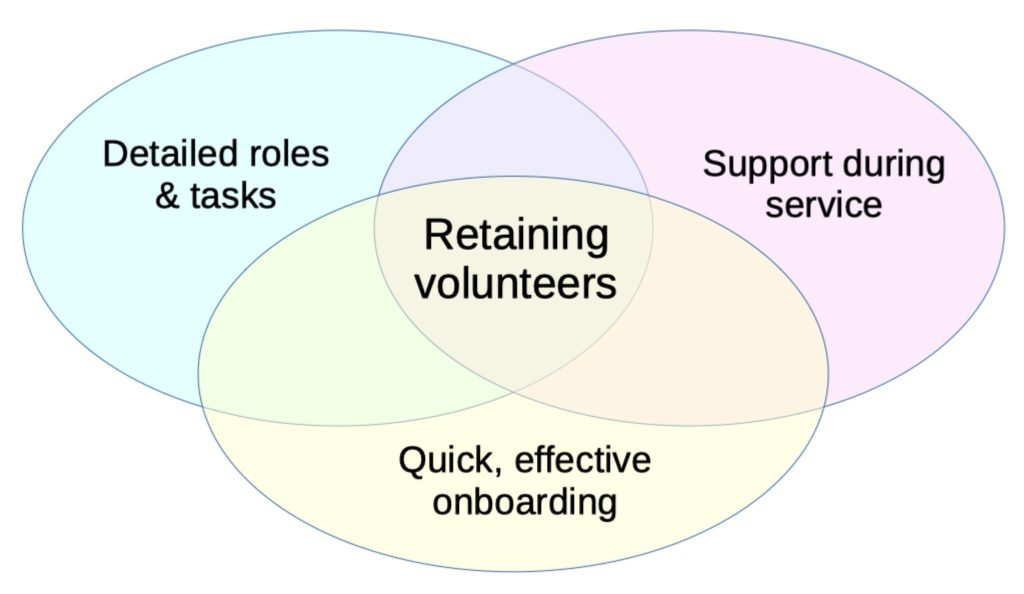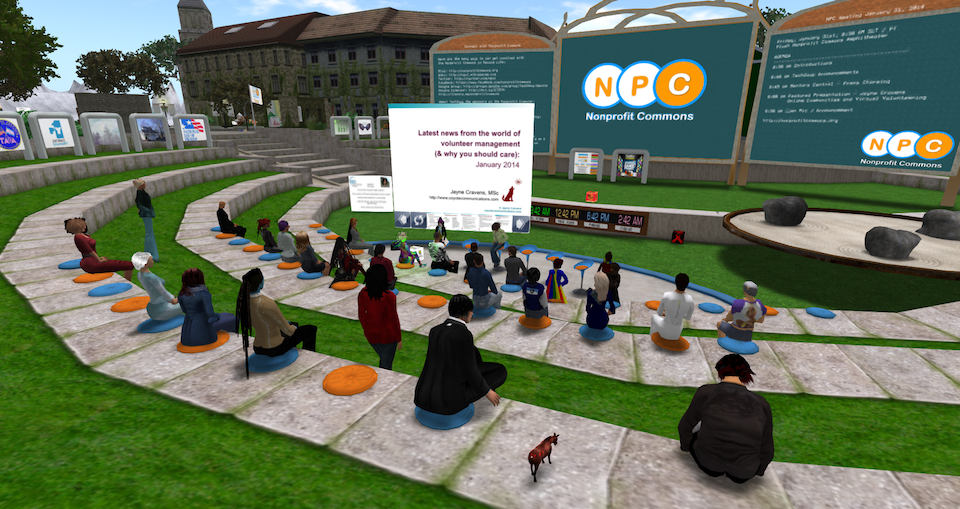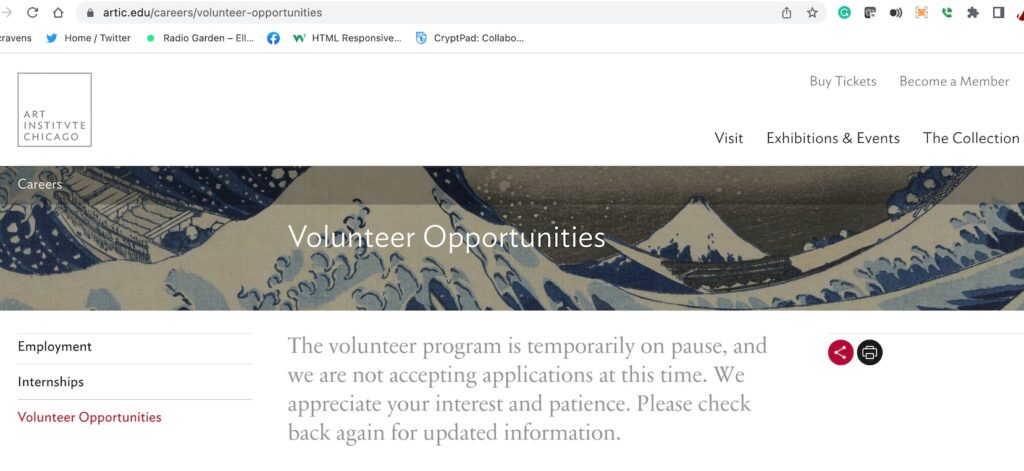Lots of people public predictions of upcoming trends in volunteer engagement – and often, these are people who are not managers of volunteers nor researchers regarding volunteerism. Their lists are things like People want micro tasks! – something many have said year after year, and something that, in practice, never seems to be what people are actually looking for, no matter what they might say in surveys. In other words, most of the lists seem to be focus on a casual, perfunctory view of volunteer engagement, not one based on reality, on actual experience.
Below is MY list of growing trends in volunteer management. It’s based on:
- what I’ve seen on online communities like the volunteer subreddit and various other regionally-based subreddits, as well as on Twitter and on TechSoup,
- what I’ve seen in the comments on Facebook posts by various nonprofits requesting volunteers,
- what I’ve seen in emails and DMs sent to me (people like to share things with me, which I very much appreciate),
- conversations with oh-so-many volunteers, wanna-be volunteers, and managers of volunteers,
- my own work with volunteers and in volunteer management.
And after my own list, I post four more points from another organization that I agree with very much (hence why I called my blog “Nine plus four emerging volunteer engagement trends.”
- People want to know why a position is unpaid & don’t always like the answer.
Especially for positions that require particular skills, like web development, video editing, graphic design, translation, online community management, accounting/financial management or social media management, people want to know why the role is unpaid instead of a paid position – and “we can’t afford to pay someone” is NOT the answer they accept. They are also pushing back against unpaid internships at nonprofits. Also, labor unions, professional associations and people with disabilities are asking why people who are experts in something are being asked to donate their services, without being paid for their time (groups that are experiencing high unemployment are particularly angry).
Most organizations don’t have a mission statement for their volunteer engagement, one that could help guide the organization on when a role should or should not be an unpaid role. Most organizations also haven’t thought about ethical issues, like the inappropriateness and disrespect to people with hearing issues of having a student studying American Sign Language trying to interpret a live event rather than someone with this particular skillset and credentials, specifically.
The result of this trend if it’s not addressed properly: a continuing backlash against ALL volunteering.
2. People want much more support as volunteers.
Especially true of public-facing volunteers, like members of school boards and people expected to support youth or at-risk populations. These volunteers are being asked to recognize and report child abuse, deal with extremely angry parents and navigate potentially violent situations. They need specific training on these issues and they need continued support regarding such – and that training and support costs money that most governments and corporations balk at funding.
The result of this trend if it’s not addressed properly: fewer people volunteering for community, city and county government advisory boards, more people with specific political agendas doing so. Fewer people volunteering for critical volunteering roles with children, or with people who might be experiencing mental health issues, meaning many programs, like youth sports leagues or programs to support homeless people, have to be canceled.
3. Volunteers want to know why their service matters.
A mug, a t-shirt, a thank you event via zoom – it’s just not enough of a “thank you” to volunteers, not anymore, and maybe it never was. Volunteers want to know WHY their service mattered. That does not mean saying the monetary value of their hours. It does not mean saying platitudes like, “We just couldn’t function without you!” Rather, it means talking regularly on social media, in the organization’s non-volunteer-focused events, and in board meetings about how what volunteers did made some kind of difference regarding the organization’s mission. It means integrating talk about the value of volunteers – and NOT monetary value – into all communications by the organization, public and internal.
4. Volunteers want to have fun, and/or an enlightening experience.
So many organizations that involve volunteers have forgotten that volunteers aren’t just laborers working for free, who show up, do what needs to be done and leave. For instance, firehouses that involve volunteer first responders seem to have forgotten the social aspects that many people seek through volunteering, and that interacting with fellow first responders outside of official duties – a sporting event, a picnic, a campout, a training or event not related specifically to their service, etc. – can help everyone recognize strengths in each other they may not have seen otherwise, further build a sense of team, and further build a connection to the community they serve.
Focusing on activities and events that are fun and that further build a sense of team and a stronger commitment to an organization and its cause is not just a good thing to do for volunteer recruitment and retainment: societies are becoming increasingly polarized. We all need to care about each other and our overall communities more, and that kind of caring comes from being around a diversity of people in contexts outside of professional work and standing in lines to buy something.
I was on a board for a nonprofit that gives away grants to arts organizations. I thought this would be a great experience to celebrate and learn about the arts in my community, but for most of the time, it’s been just work. A TON of work. In one year, I received more than 1000 emails just from fellow board members. After three years, I left, because there’s no fun. There’s no enlightenment. I was getting resentful about the arts instead of being inspired by them. The county government our organizations supported also was silent about our hours and hours of work.
5. People want “heart” from volunteering
I’ve struggled with the word to use here – personal doesn’t feel quite right. So I went with heart. What I mean is this: I think many people are just so, so hungry for very human experiences, where they hear voices, look into people’s eyes, feel like they are having a sincere, human interaction. They want to feel like they are in a community. Once it is safe to do so, people are going to fill concert halls, theaters, crafts classes, dance classes, sports events – I know this is happening in some places already, despite it spreading the deadly novel coronavirus every time, but in other places, where the culture is one more focused on personal safety and community, it’s not. Once hospitalizations finally go down, after years of a global pandemic, very personal experiences are going to be like a balm for the soul. No, that does NOT mean virtual volunteering is going away. Let me say it again: virtual volunteering can be a highly personal, even emotional experience.
Volunteers, more and more, are wanting to feel connected to other humans, and they want their volunteering service to provide some of that.
6. Managers of volunteers must master tech tools.
Not all of the tools – that’s impossible – but definitely social media (and not just Facebook), online community platforms and volunteer management software – beyond spreadsheets. The managers of volunteers that prosper – that are able to recruit and engage a diversity of volunteers in a diversity of projects and are valued within their organizations – will understand basic web design and be able to update the text on a web page, be able to edit a simple video and share it on YouTube and know how the audio software works on their laptop or phone so they can record things – like a conversation for a podcast.
7. An increasing number of traditional volunteering programs that refuse to evolve will disappear.
The town where I live no longer has an Optimist Club. Most of the remaining service clubs in town have seen dramatic drops in membership. Why? Those service clubs refuse to change: they don’t have social media channels or, if they do, they don’t update them regularly with event information, recognition of volunteers, information about how to volunteer, etc. They don’t post to the subreddit for their town. They don’t reach out to new residents. Their web site, if they have one, hasn’t been updated in years. They don’t invite the members of the high school Key Club or anyone from the high school or university newspaper to their events. They over-rely on Facebook as a way to advertise activities – and even then, don’t use it very well.
People under 40 really want to volunteer – just spend a few minutes on Reddit and you will see just how hungry young people are to volunteer. But they don’t know about service clubs, so they try to start their own. They don’t know about Meals on Wheels – that’s why they all tried to start their own meal and grocery delivery programs when the COVID-19 pandemic started. They don’t know about existing mentoring and tutoring programs, like Junior Achievement – so they try to start their own.
If your nonprofit is struggling to attract members, program participants or volunteers, here’s my challenge to you: try to find your information about such online, via a search engine or on Facebook, WITHOUT using your program’s name. Try to find it just using the name of your city and the word volunteer or community service, for instance. Here’s more on diagnosing the causes of volunteer recruitment problems (one of the most popular blogs I’ve ever written).
8. Trying to please corporate donors will further hurt volunteerism
Corporations say we want more microvolunteering, so nonprofits pour resources into creating micro tasks, something inefficient, time-consuming, and often more about creating busywork than getting things done that a nonprofit actually needs done. Also, corporations want a monetary value for volunteer time, so organizations will continue to focus on that, which will create more hostility with labor unions and the unemployed, who see it as more fuel for their argument that volunteer engagement is an effort to cut costs by cutting paid positions.
The pushback against corporations who say this is what they want is so overdue. Nonprofits have got to start saying “no” to corporations demanding volunteer engagement that is, in fact, creating conflict and more, and unnecessary, work for nonprofits.
9. Virtual volunteering will continue to become so mainstream that we stop talking about it.
Online roles and tasks for volunteers have not been unusual nor innovative for a few years now. Virtual volunteering was already widespread long before the COVID-19 global pandemic, and calling an online role virtual volunteering often isn’t even done anymore – it’s simply volunteering. Not that there isn’t going to continue to be a need to talk about creating virtual volunteering roles, managing virtual teams, supporting online volunteers, etc. – just as there is always going to be a need to talk about other volunteering modalities, like creating volunteering roles for families or corporate groups, and how best to support those groups. But that hard wall so many put up in talking about virtual volunteering as something entirely separate from traditional, onsite volunteering – that’s long been crumbling.
On a related note: back in 2017, the UK-based Association of Volunteer Managers published a blog, Ten Ten: How Does The Next Decade Look For Volunteering. These four points stood out to me then and still stand out to me now, four years later, because I think this is absolutely where volunteer engagement is going – or, at least, where it MUST go:
- The potential for volunteering will go on growing. Whether its volunteers in schools, welcoming refugees, campaigning against government cuts, or helping neighbours, we haven’t begun to reach saturation in the ways that volunteering can change society.
It’s absolutely true: we haven’t begun to reach anywhere near the saturation in the ways, the potential in the ways, that volunteering can be leveraged to improve our world. When I talk about all of the ways organizations are involving just online volunteers, I watch people’s eyebrows raise – they start to realize just how much more volunteers could be doing at their organizations. And when I talk about volunteers engaged in delivering mission-based programming, I have seen mouths start to gape as it dawns on people that volunteers are so much more than people who get tasks done.
- Volunteer managers will have specialisms just like fundraisers do. There are over 15 types of fundraising expertise. Expect volunteering management to become more and more specialist as it matures, just as fundraising has.
This is already happening, as predicted! There are volunteer managers who specialize in one-time, just-show-up group volunteering events, those who specialize in hack-a-thons and edit-a-thons, those who specialize in online transcription-based projects mobilizing hundreds of volunteers at once, those who specialize in volunteers as mentors for at-risk youth, those who specialize in volunteer activities for teens or for seniors or for immigrants or for people on parole or are incarcerated, and on and on.
- Intertwining specific audiences by demographics (eg working parents) and product (eg micro-volunteering) will be the breakfast of volunteering champions. In other words, the best organisations will understand exactly who their volunteers are, or could be, and create the volunteering products to encourage, entice and engage them ever more into giving their time.
A thousand times this! Those who manage programs for volunteer engagement will be at the table with those that manage fundraising, those that manage marketing, those that manage program, and the HR Director (because HR and volunteer engagement are NOT the same thing!).
I would word this point differently. It says originally:
- The most far-sighted charities will invest in volunteer recruitment the way they do donor recruitment. Typically they may invest several hundred pounds in donor recruitment and the total budget may amount to millions of pounds in the biggest charities. I wonder how many volunteer managers even have a recruitment budget.
Change it to this and it’s accurate:
The most far-sighted charities will invest in volunteer engagement the way they do donor recruitment. Typically they may invest several hundred pounds in donor recruitment and the total budget may amount to millions of pounds in the biggest charities. I wonder how many volunteer managers even have a budget for every aspect of their volunteer engagement, from recruitment to support to recognition to results-tracking?
And those are my predictions about trends in volunteerism. What are yours?
If you have benefited from this blog or other parts of my web site and would like to support the time that went into researching information, developing material, preparing articles, updating pages, etc. (I receive no funding for this work), here is how you can help.











